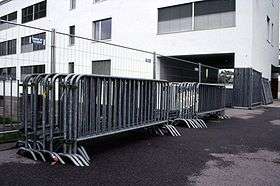Crowd control barrier
Crowd control barriers (also referred to as crowd control barricades, with some versions called a French barrier or bike rack in the USA, and mills barriers in Hong Kong[1]), are commonly used at many public events. They are frequently visible at sporting events, parades, political rallies, demonstrations, and outdoor festivals. Event organizers, venue managers, and security personnel use barricades as part of their crowd management planning.

.jpg)
Crowd control barriers act as a physical and psychological barrier, used to demarcate "no access" zones, and to designate space for lines. They are also used by riot police to control large gatherings.
Crowd control barricades are most commonly made of steel, although lighter-weight plastic variations are sometimes used. Barriers are most effective when they interlock, being attached to each other in a line via hooks at the side of each barricade. When barricades are interlocked, security personnel can create impenetrable lines, because such lines of barriers cannot easily be toppled over.
History
Nadar
Brussels mayor Jules Anspach has been credited with the invention of the crowd control barrier for the occasion of the visit of the French photographer Nadar to Brussels. On his visit to Brussels with the balloon Géant, on September 26, 1864, Anspach erected mobile barriers to keep the crowd at a safe distance.[2] Up to this day, crowd control barriers are known in both Belgian Dutch and Belgian French as Nadar barriers.[3]
Wooden sawhorses
In the mid-to-late 20th century a common version was made of wood in the shape of a sawhorse. The legs are similar but rather heavy duty facsimiles of the hobby sawhorse-version, and about the same height. The horizontal bar consists of a heavy duty plank about 4.2 metres (14 ft) long with printed on it in large letters: Police Line - Do Not Cross. Beginning in the 1980s, steel barriers gradually took the place of wooden sawhorses at many events, including major holiday parades in New York City.
Interlocking steel barriers
Interlocking steel barriers were patented in France in 1951. The original "Samia" barrier was developed to meet the need to maintain safety and order during France's social upheaval of the 1950s. This type of barricade soon became adopted for crowd control in other European countries, and eventually, the United States. Samia eventually went out of business, but many variations on its original barrier evolved over the years.
Barriers became an increasingly common sight, and without much fanfare, blended into the popular culture. Americans soon became accustomed to barriers being part of the background at important events. One of the earliest and most famous examples was the use of barriers at John F. Kennedy International Airport in New York City to control the hysterical crowds which greeted The Beatles' arrival in the U.S. in 1964. Steel crowd control barricades have been a common sight at the Olympic Games since the 1980s.
Characteristics
Numerous suppliers and fabricators have created crowd control barricades, but over the years, some unofficial standards have been generally accepted. These characteristics have been inherent in the barricades offered by the leading suppliers since the 1990s.
The international standard barrier lengths are 1-metre, 2-metre, and 2.5-metre. The standard height (for optimum safety and visibility) of a barrier is 43 inches (approximately 109 cm). An 8-foot barricade weighs approximately 55 pounds (25 kilograms).
To prevent damage, standard barricades are made of 16-gauge steel tubing, measuring 1.5 inches on the outside diameter. Quality barricades are also hot dip galvanized after fabrication, which allows the barriers to be placed and even stored outside without the danger of rusting.
Some barricades are manufactured with bases welded to the barrier; others feature bases which are bolted on. The latter are advantageous because they are replaceable (a new base can be inserted; thus damage to a base doesn't render the remainder of the barrier unusable). There are four main styles of replaceable bases: flat bases, bridge bases, U bases, and wheel bases, all of which offer advantages in different circumstances.
Crowd control barricades are sometimes placed side by side without being attached, but they are most effective when they are hooked together. Without a solid interlock, barriers can be lifted out of place by individuals in a crowd, compromising the integrity of a line. The most popular hook style is the "classic" style in which the male hooks are 15 inches apart. The second most common, the "wide hook" style, has the male hooks 25 inches apart.
See also
- Chicane (barrier)
- Crowd control
- Temporary fencing
- Vinyl fence
- Privacy fencing
- Crowd manipulation
- 2009 Birmingham Millennium Point stampede
Notes
Steel crowd control barriers reinforce a thinner blue line at NYC parades. (NY Times 2003)[4]
- "Newly designed mills barriers". Press releases. Hong Kong Government. 23 January 2002. Retrieved 26 November 2014.
- https://bruges-la-morte.net/wp-content/uploads/Baudelaire_Bruxelles.pdf
- Nadarafsluiting at www.cornille-mct.be
- https://www.nytimes.com/2003/07/27/nyregion/steel-barriers-reinforce-a-thinner-line-of-blue-at-parades-and-the-bottom-line.html
External links
| Wikimedia Commons has media related to Crowd control barrier. |

